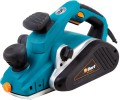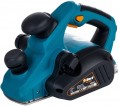Power consumption
The total power consumed by the electric planer during operation. The more powerful the tool, the generally higher its productivity and the better it is suitable for large volumes of work and/or hardwoods. Here, however, it must be taken into account that the effective power (the power supplied by the unit directly to the working tool) is anyway lower than the consumed one, but it is far from always indicated. Therefore, it is quite possible to compare different models with each other precisely in terms of power consumption.
Note that more power means higher electricity consumption, and also, most often, more weight and cost of the tool. Therefore, it does not always make sense to chase the most powerful units. So, for occasional use and small volumes of work, a power of 500-600 W is considered quite sufficient; for regular work on relatively soft wood, 700-800 W is enough, and professional models have a power of more than 1000 W.
Rotation speed
The maximum speed of rotation of the working tool of the electric planer — a drum with knives attached to it. In modern models, this figure is practically never lower than 10,000 rpm (otherwise it is impossible to ensure normal quality of work), and in most cases it is in the range of 11,000 – 17,000 rpm. It is believed that the higher the number of revolutions, the more evenly the workpiece is processed and the smoother the surface is obtained; and the overall speed of work will be higher. On the other hand, a high speed also requires high engine power, especially when working with hardwoods; for such materials, it makes sense to use a low-speed tool — it will provide more efficient power distribution.
Planing width
The width of the strip that the planer processes in one pass. The larger this width, the fewer passes will be needed for surface treatment and the more convenient it will be to work with large workpieces. In most modern electric planers, this figure varies between 80-100 mm.
Note that a larger width requires a more powerful engine and can significantly affect the cost of the tool.
Planing depth
The greatest thickness of the layer of material that the planer can remove in one pass (most often the design provides for depth adjustment). The larger this parameter, the more performant the tool will be and the better it will be suitable for large-scale work. On the other hand, in fact it is rarely necessary to remove a large amount of material at a time, and tools capable of this require powerful (and therefore expensive) motors. Therefore, in most consumer-level models, the planing depth does not exceed 2 mm; more "deeper" units, usually, belong to the professional class.
Grooving depth
The greatest depth of the groove that can be cut into the workpiece with a planer.
Grooves are narrow and long slots used, in particular, for tenoning wooden parts. Some models of electric planers are equipped with special tools that make it easier to cut grooves.
Noise level
The maximum noise level produced by the planer during operation. The lower this indicator, the more comfortable the use of the tool, the less inconvenience it creates for both the user and others. Note that the noise level is measured in decibels, and this is not a linear unit — in other words, sounds with a difference of several dB in volume can differ significantly. A few examples for comparison: 75 dB noise is approximately equivalent to a scream, 80 dB is a motorcycle engine, 85 dB is a loud scream, 90 dB is the sound of a freight car moving at a distance of 5-6 m, 95 dB is the noise inside a subway car.

